Phimeanakas Temple Overview
The temple of Phimeanakas is situated near the center of the area enclosed by the walls of the Royal Palace. It must originally have been crowned with a golden pinnacle, as Zhou Daguan described it as the Tower of Gold The temple is built of roughly hewn sandstone blocks and has little decoration.
According to legend there was a gold tower (Phimeanakas ) inside the royal palace of Angkor the Great where a serpent-spirit with nine heads lived. The spirit appeared to the Khmer king disguised as a woman and the king had to sleep with her every night in the tower before he joined his wives and concubines in another part of the palace. If the king missed even one night it was believed he would die. In this way the royal lineage of the Khmer was perpetuated.
Below is the glimpse of Phimeanakas Temple in 360o viewing:
The history of Phimeanakas
Phimeanakas was built at the end of the 10th century by King Rajendravarman and completed by King Suryavarman I. It was built as a Hindu temple in the Khleang style inside the Royal Palace of Angkor Thom.
It’s believed that an earlier structure was built here in the early part of the 10th century and knocked down to make way for Phimeanakas. There is an inscription which as been dated to 910 AD and mentions a structure which was dedicated to Vishnu.
Desertion
The temples at Angkor were all deserted at some point in the 16th century and Phimeanakas was the same. It is not exactly known why the Khmer deserted these great structures.
20th Century – Today
The French explorer, Henri Marchal, discovered a broken stela which was apparently written by King Jayavarman VII’s second wife. It tells us about the king and his both his first and second wives. The queens had an important role in spreading the Buddhist religion across the kingdom. The stela also shows battles between the Khmer and the Chams as well as King Jayavarman VII’s coronation.
Most of the structure remains intact and has been open to tourists for years. It’s widely visited and welcomes thousands of visitors each day.
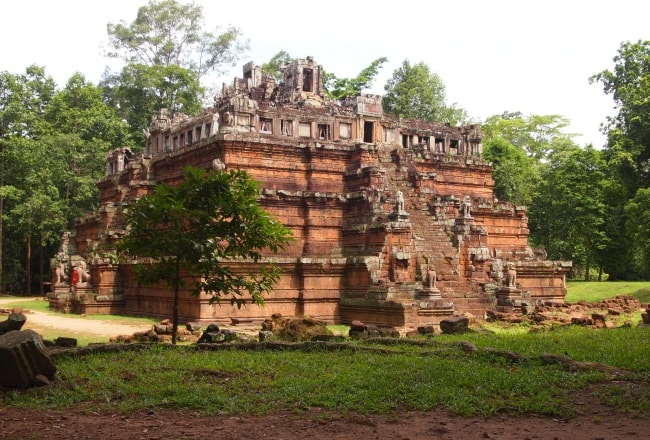
The Architecture of Phimeanakas
The general plan of Phimeanakas is rectangular. the temple originally consisted of a Central Sanctuary on a tiered base and an enclosing wall. The grounds around the sanctuary included several courts and ponds.
A laetrile wall encloses the temple and a second enclosing wall was built at a later date. Next there is a dry moat.
The sandstone entry tower at the east is in the shape of a cross with two wings; the lintels have a central motif of a head of a Kala and the window frame is inscribed. These features are not shown on the plan.: eave the tower and walk towards the main sanctuary. On the right (north) there is a pond with molding and laetrile steps. It may have been a part of the palace reserved for woman.
Return to the center walkway; after leaving the entry tower turn right and follow a path until you come to another large pond paved in laterite with sandstone steps. It was bordered by two stairways with bas0reliefs-along the side there are serpents in animal and human form surrounded by serpent-princesses; on the top there are male and female Garudas and mythical winged figures.
This entire area was probably crowned by a serpent balustrade and may have served as a gallery for the sovereign and dignitaries of the court. It is separated from the north-enclosing wall by paved causeways and from another pond on the east.
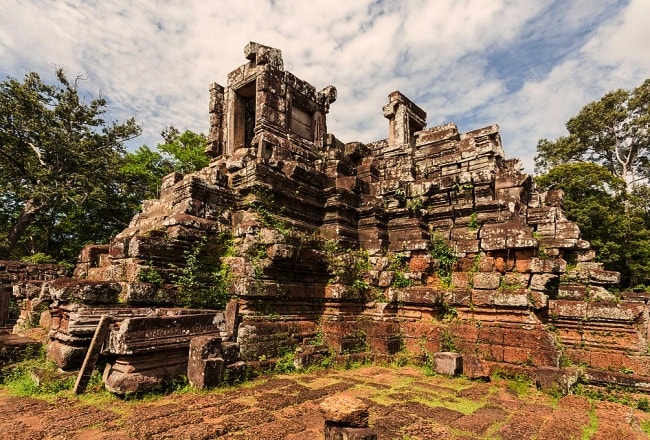
Central Sanctuary
The single sanctuary is on a base with three laterite tiers. It is approached by four steep stairways, one on each side. These stairways are framed by walls with six projections- two per step –decorated with lions. Elephants once stood on sandstone pedestals in the corners of the base but today they are mostly broken.
Upper Terrace
The upper terrace affords a spectacular view of the neighboring temple of Baphuon. A narrow covered sandstone gallery (2) with windows and balusters at the edge of the upper terrace is a unique architectural feature. There were small pavilions at the corners but only vestiges remain.
Entrance gopura
The temple is oriented towards the East. The main entrance consists of a gopura building with a central entrance door with a single tower on top of it, flanked by two somewhat smaller entrance doors. The door jambs contain an inscription dated 1011 of the oath of allegiance to the Angkor King.
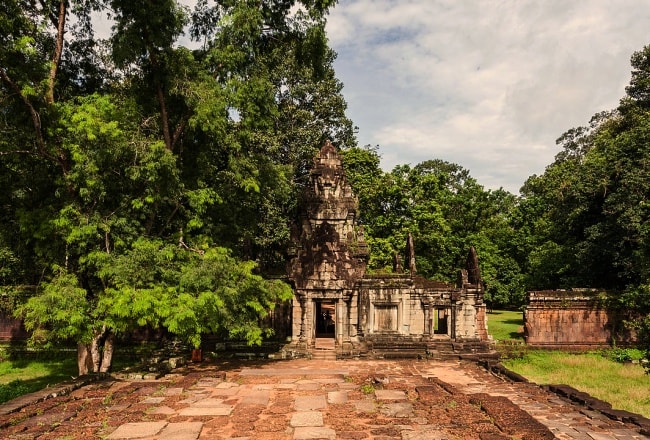
3 steep tiers of the pyramid
The Phimeanakas pyramidal structure consists of 3 tiers of diminishing size. At the base the structure measures 35 meters long by 28 meters wide, the upper platform measures 30 meters long by 23 meters wide. A very steep stairway leads to the top on all of its four sides guarded by lion statues. Most accessible is the one on the Western side, which is equipped with a handrail. At the corners of each of the tiers are guardian elephant statues.
Galleries and sanctuary at the top
On top of the pyramid is a platform surrounded by small galleries. These were the first vaulted galleries to be built in Angkor, which have been copied on a grander scale in the later monuments. These galleries probably replaced older galleries made out of perishable materials. At the center of the platform are the ruins of a small cruciform sanctuary with four vestibules opening to each of the cardinal points. The structure was likely a later addition to replace the original wooden structure, the “Golden Tower” that Zhou Daguan describes in his accounts of Angkor.
The Phimeanakas stele
In 1916 Henri Marchal of the EFEO discovered a broken stele during excavation works of temple near the Eastern stairway up the temple. The stele, written by King Jayavarman VII’s second wife, contains a wealth of information about the King, his first wife who had passed away and his second wife.
The stele tells of the important role the two Queens had in the spreading of Buddhism and of their achievements. It also describes a number of important events that took place during the life of Jayavarman VII, such as battles between the Khmer and the Chams and the King’s coronation in 1181.
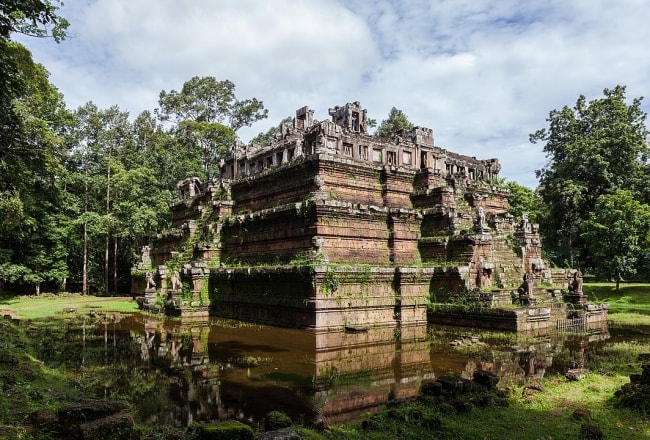
The Legend of the 9-headed Serpents
The accounts of Zhou Daguan, the Chinese diplomat who lived in Angkor for a year at the end of the 13th century tell about a legend, believed by the common people of Angkor.
On top of the Phimeanakas, known as “the Golden Tower” lived a spirit in the form of a nine headed snake, that is the Lord of the Khmer Kingdom. Every night the spirit appears in the form of a woman. The King had to climb to the top of the tower and sleep with the spirit. Should he fail to do this for one night, a great disaster is to strike the Kingdom. In case the spirit fails to appear, the King is about to die.
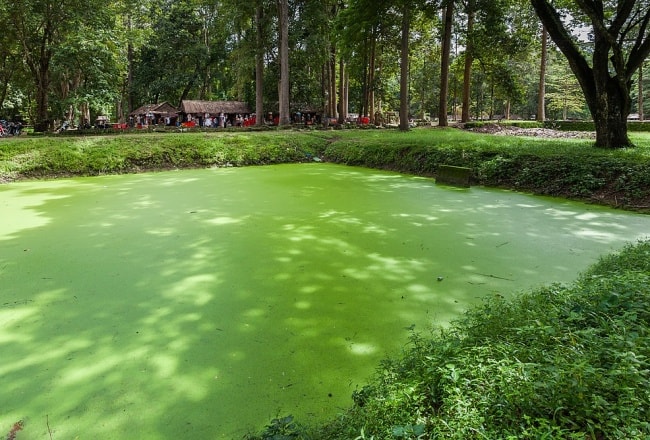
Preparing for visiting Phimeanakas Temple
Temple Facts
- Date: Late 10th century
- Religion: Hindu
- Built By: Rajendravarman / Suryavarman
- Dedicated To: Unknown
- Style: Khleang
- Best Time to Visit: Anytime
- Length of Visit: 30 - 60 minutes
- Temple Pass: Required
Location
Phimeanakas temple is located inside the Royal Palace in Angkor Thom. It’s just north of Baphuon temple and West of the Terrace of the Elephants and the Terrace of Leper King. A few hundred metres to the north is Prasat Preah Palilay.
Check the location of Phimeanakas on Google Maps for your reference:
Getting There
You can reach Phimeanakas on foot from Baphuon in the south, Terrace of the Elephants in the East, or Preah Palilay in the north. Most visitors will approach the temple from the East as the Angkor kings would have done. As you’re walking from the Terrace of the Elephants, keep going for around 200m. There is a path through the trees which will take you to the front of the temple.
Phimeanakas Tours
Tours of Phimeanakas are often included in variations of the Small Circuit and Big Circuit tours. In some cases, the small tour will bypass many of the temples in Angkor Thom and just take you to the “big three” of Angkor Wat, Bayon and Ta Prohm.
Many small circuit tours do stop at other temples in Angkor Thom including Phimeanakas, it’s best to check the tour itinerary before you book.
Accommodation
Like all temples in Angkor Thom, there are no places to stay in the vicinity. As most tours will leave from the town and visit many temples in the area, it’s likely that you will find accommodation in Siem Reap. There are many hotels of all sizes and prices. Some popular hotels can fill up quickly in the high season, so it’s sometimes best to plan ahead.
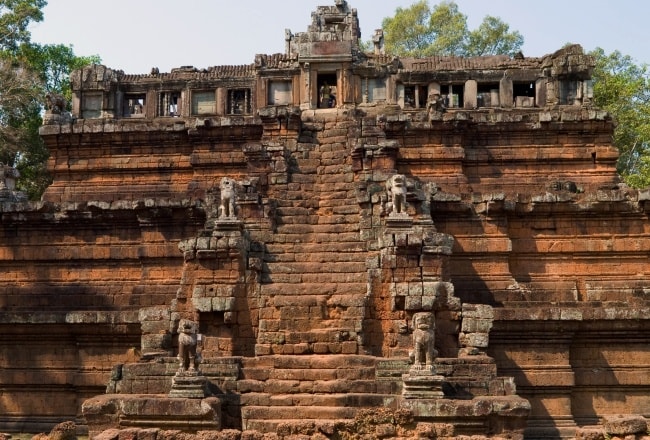
Why Visit Phimeanakas?
Phimeanakas is a temple with a story and everyone loves a good story! It’s also part of the royal enclosure, so it’s likely that you’ll pass through at some point during your visit. The area surrounding the temple is thick with trees and ponds which make it feel a little cooler which is great if you’re visiting in the hot afternoon.


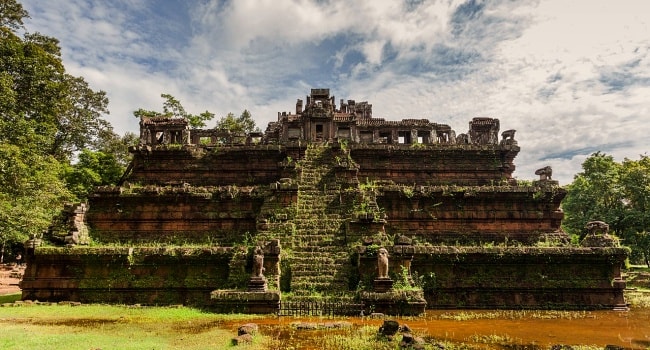

 05/01/2026
05/01/2026





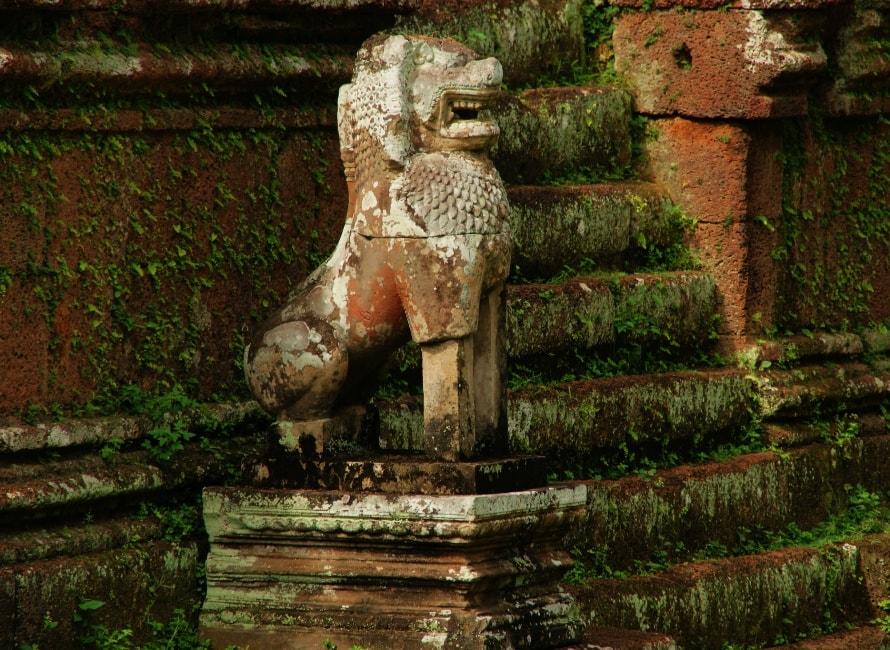
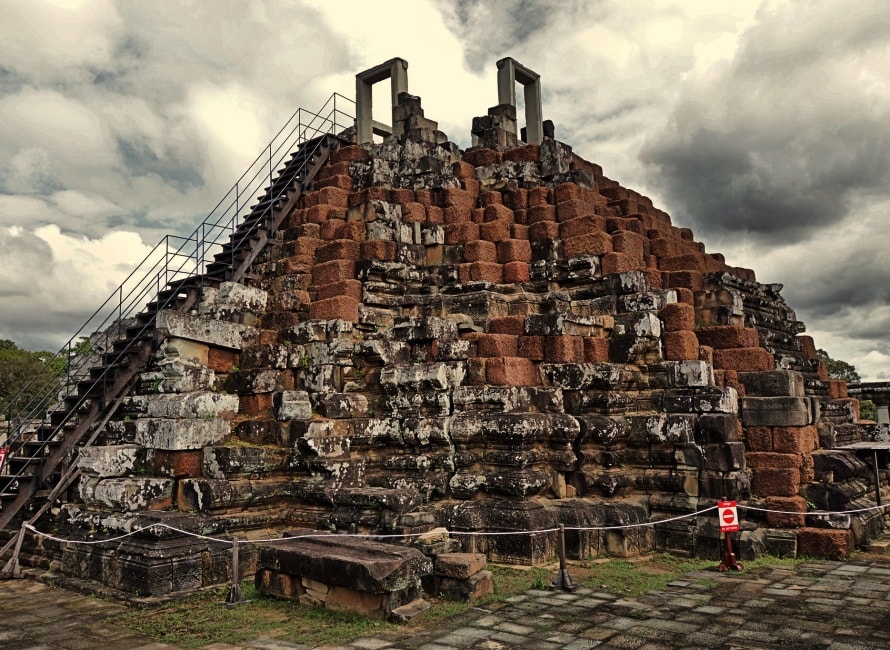



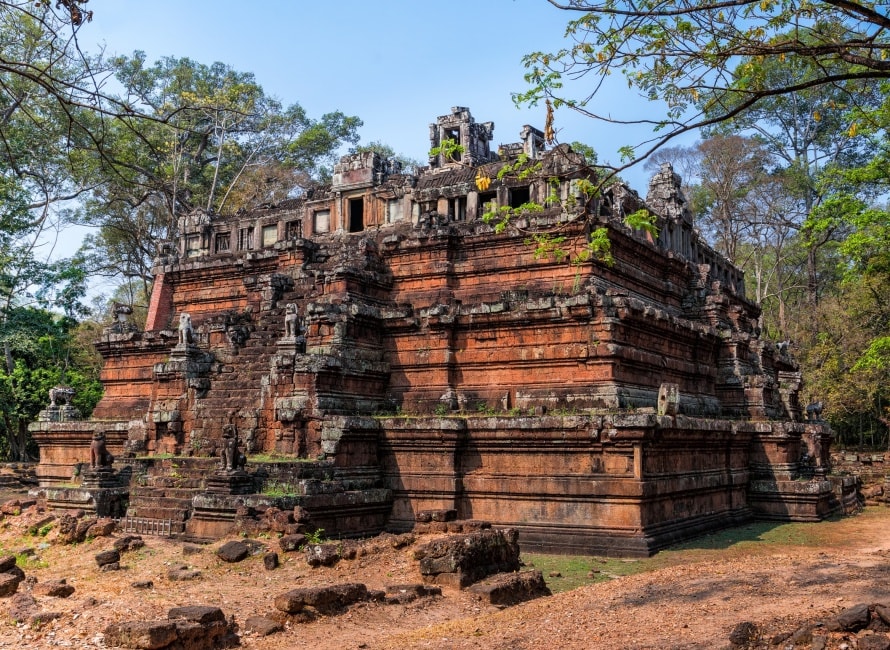
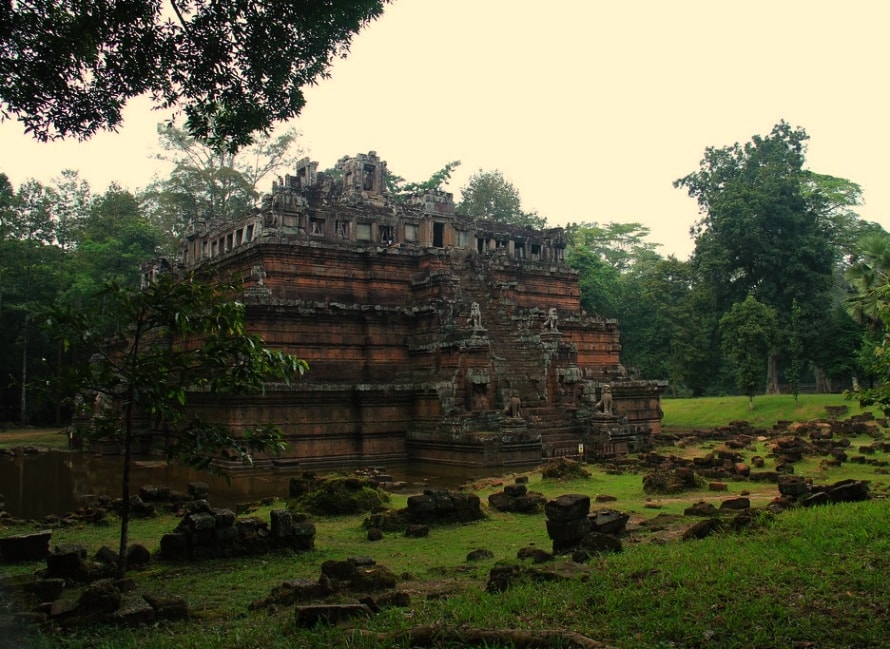
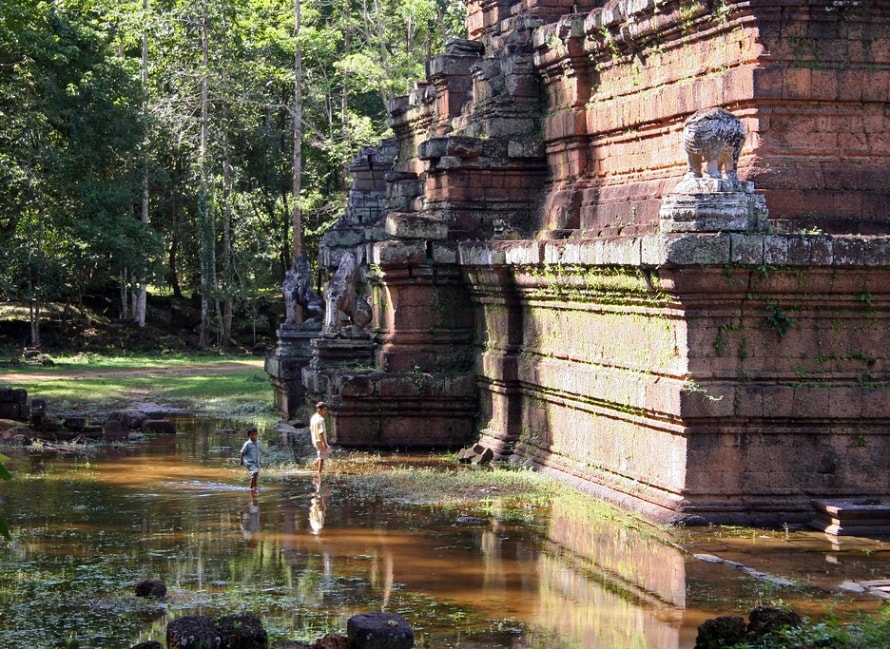
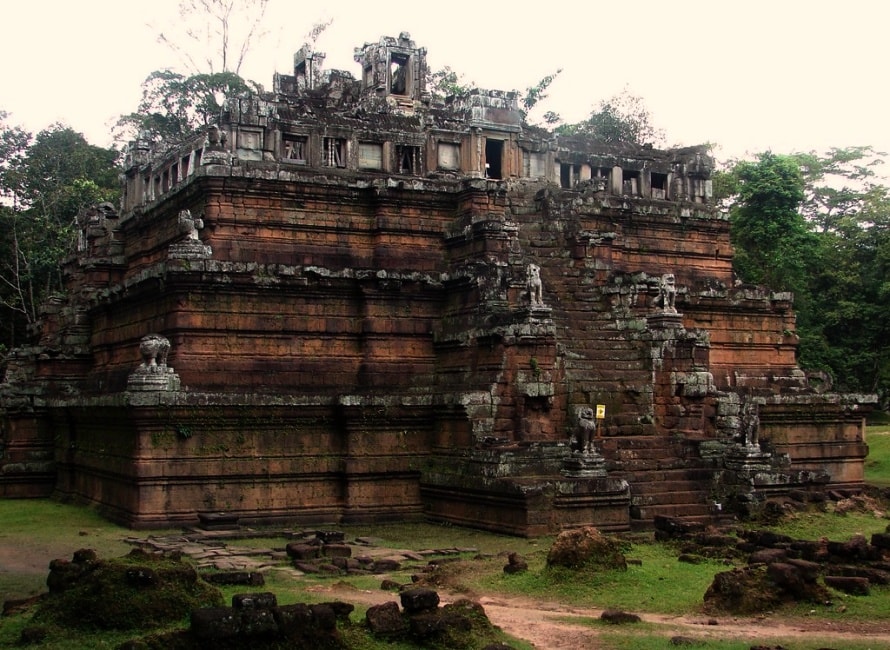




















Jolie LIEMMy name is Jolie, I am a Vietnamese girl growing up in the countryside of Hai Duong, northern Vietnam. Since a little girl, I was always dreaming of exploring the far-away lands, the unseen beauty spots of the world. My dream has been growing bigger and bigger day after day, and I do not miss a chance to make it real. After graduating from the univesity of language in Hanoi, I started the exploration with a travel agency and learning more about travel, especially responsible travel. I love experiencing the different cultures of the different lands and sharing my dream with the whole world. Hope that you love it too!